

Evaluating Sources: OPVL Protocol. 40 Best Social Studies Websites for Kids and Teachers to Learn. Social Studies Lessons Big History Project Focused on high school students, the Big History Project is a joint effort between teachers, scholars, scientists, and their supporters to bring a multi-disciplinary approach to knowledge Crash Course World History This fantastic YouTube channel provides an engaging glimpse into some of the most notable events and developments in history.
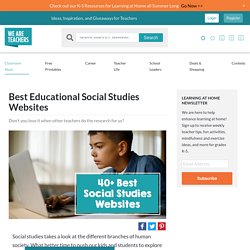
With sequences of videos on the World Wars, the history of science, U.S. Crash Course Kids The creators of Crash Course have also created a second channel geared towards younger students. EdTechTeacher Need a list of some great history websites? The Gilder Lehrman Institute of American History A nonprofit organization that has developed an array of programs for schools, teachers, and students that now operate in all fifty states, including a website that features more than 60,000 unique historical documents. Library of Congress It’s hard to beat the National Library of Congress. National Archives Rozzy Learning J. U.S. The University of New Mexico. College of Arts & Sciences History, B.A.
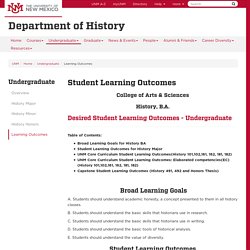
Desired Student Learning Outcomes - Undergraduate Table of Contents: Teaching Social Studies Through Film (2009) c3 framework for social studies rev0617. The World If. Stanford History Education Group. The Best Social Studies Sites Of 2015 — So Far. World History Timeline - The FREE atlas of world history combining timelines and maps to navigate history. Express 10.09 - Doing the Work of Historians. Doing the Work of Historians Authentic Questioning in Social Studies Amy Lynn Mount Let's face facts: social studies has an image problem.

I can count at least half a dozen times I've attended PD where the old "Saturday Night Live" skit with Jerry Seinfeld playing the stereotypical history teacher is trotted out. Even though it's a parody of our work, it also resonates with mainstream perceptions. Yet, in an increasingly globalized society, social studies matters more than ever. According to the National Council for Social Studies, a great social studies education "engage(s) students with significant ideas, and encourages them to connect what they are learning … and to apply that learning to authentic situations" (2008).
The idea that authentic experiences in social studies are important isn't a new one. Authentic learning and assessment are highly compatible with the nature and purpose of social studies. So why aren't we all making social studies instruction more authentic? References. Express 9.13 - Teaching Students to Read like Historians. Teaching Students to Read like Historians Deni Basaraba, Gina Biancarosa, Sarah Carlson, and Lina Shanley Research indicates a significant gap between what it means to read like a historian and the way students typically read historical texts (Shanahan, 2012).
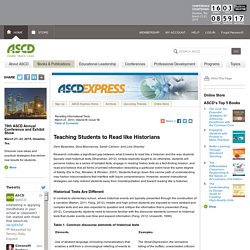
Unless explicitly taught to do otherwise, students will perceive history as a series of isolated facts, engage in reading history texts as a fact-finding mission, and read and believe that all forms of printed information describing a particular event have the same degree of fidelity (De la Paz, Morales, & Winston, 2007). Students that go down this narrow path of understanding may harbor misconceptions that interfere with future comprehension. However, several instructional strategies can help redirect students away from misinterpretation and toward reading like a historian.
Historical Texts Are Different Table 1. Source information across multiple documents. Strategies for Reading Historical Texts References Barton, K. Williams, J. About the Program. The Choices Program is non-profit organization based at Brown University.
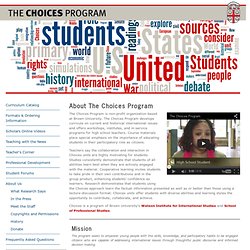
The Choices Program develops curricula on current and historical international issues and offers workshops, institutes, and in-service programs for high school teachers. Course materials place special emphasis on the importance of educating students in their participatory role as citizens. Teachers say the collaboration and interaction in Choices units are highly motivating for students.
Studies consistently demonstrate that students of all abilities learn best when they are actively engaged with the material. Cooperative learning invites students to take pride in their own contributions and in the group product, enhancing students’ confidence as learners. Big History. History Vs. Hollywood: Examining Accuracy in the Movies.
By Frank W.
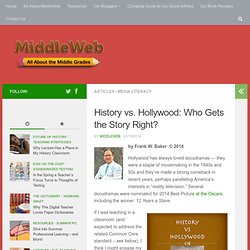
Baker © 2014 Hollywood has always loved docudramas — they were a staple of moviemaking in the 1940s and 50s and they’ve made a strong comeback in recent years, perhaps paralleling America’s interests in “reality television.” Several docudramas were nominated for 2014 Best Picture at the Oscars, including the winner: 12 Years a Slave. If I was teaching in a classroom (and expected to address the related Common Core standard – see below), I think I might engage my students with this question: What was true, and what was not, in that docudrama you saw last weekend?
They could be assigned a recent film, or one you use in the classroom, and be tasked with researching how the filmmakers stayed faithful to, or swayed from, the historical record. In this excerpt from a Hollywood Reporter story about the eagerness to “fact-check” docudramas, the author writes: But today we live in the age of Google, when a quick fact-check is just an Internet search away. What the Common Core says. ASCD VLN—Social Studies.